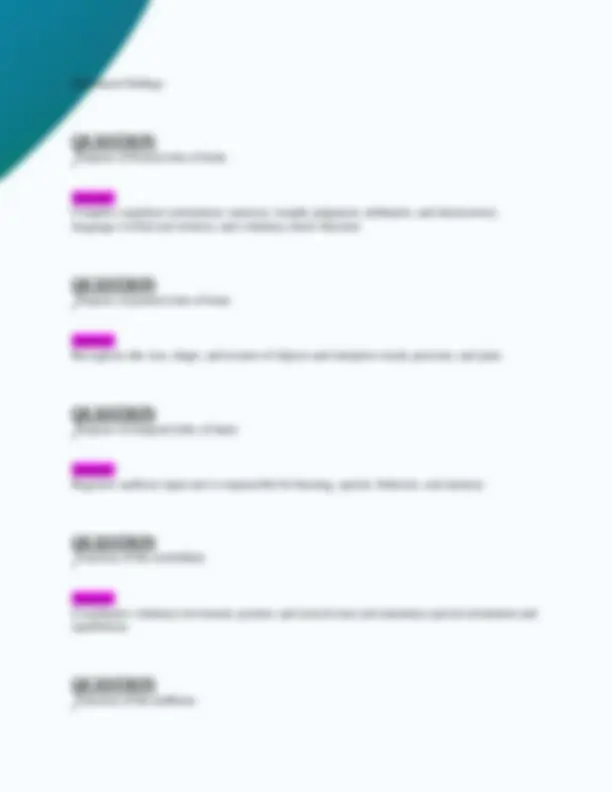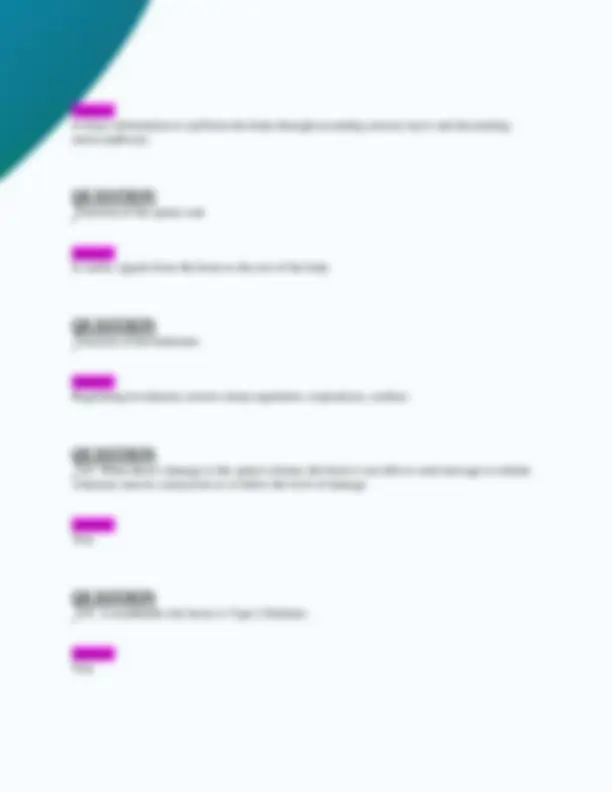











Study with the several resources on Docsity

Earn points by helping other students or get them with a premium plan


Prepare for your exams
Study with the several resources on Docsity

Earn points to download
Earn points by helping other students or get them with a premium plan
Community
Ask the community for help and clear up your study doubts
Discover the best universities in your country according to Docsity users
Free resources
Download our free guides on studying techniques, anxiety management strategies, and thesis advice from Docsity tutors
NSG121/ NSG 121 Exam 4: ( 2025/ 2026 Update) Health Assessment | Review with Questions and Verified Answers| 100% Correct| A Grade - Herzing
Typology: Exams
1 / 15

This page cannot be seen from the preview
Don't miss anything!










What does a grade 3 muscle strength look like? Answer: Active movement against gravity
What is stereognosis? Answer: Place something in the patient's hand and they should identify it
What is graphesthesia? Answer: Draw on number or letter on patient's palm and they should be able to identify it
Normal Babinski sign in adult Answer: Toes curl, big toe dorsiflex
T/F: An urgent situation when reviewing the hospitalized patient would be a new seizure, a change in the pupillary response, and the urine output less than 50 mL in 4 hours Answer: True
T/F: Common complications in hospitalized patients include placement of chest tube Answer: False
What is included in a general shift assessment? Answer: Vital signs, pain assessment, neuro, general survey, abd, resp, lines, tubes, bed alarms
Lab value that tells you if a patient is pregnant Answer: hCG
T/F: Nausea is normal in 2nd trimester Answer: False, normal in 1st trimester
Pre-eclampsia
T/F: A child should triple their weight by 2 years old Answer: False, by 1 year old should be triple
Autonomy vs shame and doubt is what Erikson stage? Answer: 1.5- 3 years old
Industry vs inferiority is what Erikson stage? Answer: 5 - 12 years old
At age 10 RR slows down, why? Answer: Right number of alveoli now, increased lung volume
Purpose of obstetrical and birth history from mom
Answer: Physical and developmental difficulties
Risk factors of lead poisoning Answer: Home built before 1950, remodeled around 1978, friend with lead poisoning
Positioning for sleeping babies Answer: Supine
When are well child checkups held? Answer: 3 - 5 days after delivery, 2, 4, 6, 9, 12 months
What 5 areas does Apgar assess? Answer: Appearance (skin color) Pulse Grimace (reflex irritability) Activity (muscle tone) Respiration
How would you communicate to a patient who has an injury to Broca's area? Answer: Pictures, whiteboard, allowing them to express their thoughts
Damage to the Wernicke's area will cause what? Answer: Difficultly integrating understanding of spoken and written words
T/F: A client with stupor can respond to a stimulus but will be slow to respond Answer: False, that is drowsiness
Order to assess LOC Answer:
What would you do differently for a routine and focused neuro assessment?
Answer: Routine: LOC, attention, inspect pupillary response, walk, balance, muscle tone Focused: DTR, position sense (finger up or down), 2-point discrimination
What cranial nerves assess oculomotor? What tests would you do? Answer: 3, 4, 6 Whisker test, PERRLA, convergence, accommodation
What cranial nerve assesses olfactory? What tests would you do? Answer: 1 Have them smell a common scent (cinnamon, peppermint)
What cranial nerve assesses optic? What tests would you do? Answer: 2 Snellen chart
What cranial nerve assesses trigeminal? What tests would you do? Answer: 5 Chewing, TMJ, temples, cotton on face
Answer: 11 Shrug shoulders
What cranial nerve assesses hypoglossal? What tests would you do? Answer: 12 Stick out tongue, should be midline
T/F: Important to keep noise level to a minimum when assessing infant Answer: True
T/F: DBP increases in elderly Answer: False
T/F: Elderly have an increased sense of taste Answer: False
T/F: Elderly have limited chest expansion Answer: True
When might SBP increase in elderly? Answer: Arteriosclerosis
T/F: Typically elderly have a fluid volume excess Answer: False, deficit unless they have CHF
T/F: Medical history in an elderly patient should be obtained from the client's medical record Answer: False
What might you ask the client to assess nutritional risk factors? Answer: What type of food they're eating, sugar and salt intake, red meat consumption
Document findings
Purpose of frontal lobe of brain Answer: Complex cognition (orientation, memory, insight, judgment, arithmetic, and abstraction), language (verbal and written), and voluntary motor function
Purpose of parietal lobe of brain Answer: Recognizes the size, shape, and texture of objects and interprets touch, pressure, and pain.
Purpose of temporal lobe of brain Answer: Registers auditory input and is responsible for hearing, speech, behavior, and memory
Function of the cerebellum Answer: Coordinates voluntary movement, posture, and muscle tone and maintains special orientation and equilibrium
Function of the midbrain
Answer: It relays information to and from the brain through ascending sensory tracts and descending motor pathways
Function of the spinal cord Answer: It carries signals from the brain to the rest of the body
Function of the brainstem Answer: Regulating involuntary actions (temp regulation, respirations, cardiac)
T/F: When there's damage to the spinal column, the brain is not able to send message to initiate voluntary muscle contraction at or below the level of damage Answer: True
T/F: A modifiable risk factor is Type 2 Diabetes Answer: True